Wanted to know if any members knew of a reference for the blueing methods used by the French in the 15th, 16th and 17th centuries. Thanks
-
This community needs YOUR help today. We rely 100% on Supporting Memberships to fund our efforts. With the ever increasing fees of everything, we need help. We need more Supporting Members, today. Please invest back into this community. I will ship a few decals too in addition to all the account perks you get.

Sign up here: https://www.muzzleloadingforum.com/account/upgrades -
Friends, our 2nd Amendment rights are always under attack and the NRA has been a constant for decades in helping fight that fight.
We have partnered with the NRA to offer you a discount on membership and Muzzleloading Forum gets a small percentage too of each membership, so you are supporting both the NRA and us.
Use this link to sign up please; https://membership.nra.org/recruiters/join/XR045103
You are using an out of date browser. It may not display this or other websites correctly.
You should upgrade or use an alternative browser.
You should upgrade or use an alternative browser.
Blueing
- Thread starter Nor'Easter
- Start date

Help Support Muzzleloading Forum:
This site may earn a commission from merchant affiliate
links, including eBay, Amazon, and others.
- Joined
- Nov 26, 2005
- Messages
- 5,017
- Reaction score
- 9,964
Hi,
They used 2 kinds if at all. Temper bluing and charcoal bluing. The first is simple, just polish the parts very well, degrease, and then heat the component to 580-600 degrees and let cool. The second is more complicated. Polish the parts highly and thoroughly degrease them. Then pack them in bone charcoal with a steel box or tank, with lid. Then heat to about 700 degrees for 3-4 hours, remove from the heat and let cool. Then either gently card the part with a very soft stainless steel wheel (bristles no thicker than 0.006") or polish the part with a rag dipped in linseed oil and rottenstone. Then clean and degrease, and heat again in charcoal. Polish and repeat until the blue color evens and is partly translucent.
dave
They used 2 kinds if at all. Temper bluing and charcoal bluing. The first is simple, just polish the parts very well, degrease, and then heat the component to 580-600 degrees and let cool. The second is more complicated. Polish the parts highly and thoroughly degrease them. Then pack them in bone charcoal with a steel box or tank, with lid. Then heat to about 700 degrees for 3-4 hours, remove from the heat and let cool. Then either gently card the part with a very soft stainless steel wheel (bristles no thicker than 0.006") or polish the part with a rag dipped in linseed oil and rottenstone. Then clean and degrease, and heat again in charcoal. Polish and repeat until the blue color evens and is partly translucent.
dave
Thank you Dave. With the charcoal bluing - does the container need to be air tight. In the past I've hardened my lock steels in a large piece of black iron pipe threaded on both ends. I pack it then screw caps on. Would that work for the bluing also? One more question - is bone charcoal homemade or is it purchased? Thanks, Bill
Below are some French weapons from that era I've found that appear to be blued.
https://basedescollections.musee-ar....simple.highlight=silex.selectedTab=thumbnail
https://basedescollections.musee-ar....simple.highlight=silex.selectedTab=thumbnail
https://basedescollections.musee-ar...light=Arquebuse à rouet.selectedTab=thumbnail
https://basedescollections.musee-ar...ighlight=Arquebuse à rouet.selectedTab=record
Below are some French weapons from that era I've found that appear to be blued.
https://basedescollections.musee-ar....simple.highlight=silex.selectedTab=thumbnail
https://basedescollections.musee-ar....simple.highlight=silex.selectedTab=thumbnail
https://basedescollections.musee-ar...light=Arquebuse à rouet.selectedTab=thumbnail
https://basedescollections.musee-ar...ighlight=Arquebuse à rouet.selectedTab=record
- Joined
- Nov 26, 2005
- Messages
- 5,017
- Reaction score
- 9,964
Hi Nor'Easter,
No, the lid can be loose but the part needs to be packed tightly in the charcoal to prevent air from contacting the metal. I put a layer of wood charcoal first in the box, then pour in bone charcoal. The parts are bedded in the bone charcoal because of the finer grain and greater air exclusion capacity. I add more bone charcoal on top and fill out any residual space with wood charcoal. The top of my box is loose. I buy bone and wood charcoal from Brownells but I believe there are much cheaper sources. I don't recommend making it because it must be very clean burning to get good results. I am familiar with the guns you posted and suspect the barrels were temper (fire) blued. Essentially, they were polished bright, degreased and then placed among nonsmoking and mostly burnt coals in the forge. They were kept in the heat until the blue color emerged, immediately removed and rubbed with oil and emery, then degreasing, and heating again. It was almost like charcoal bluing except the barrel was not completely packed in the coals so the gunsmith could see the color change. A description of this can be found in the book "Espingarda Perfeyta", which is available online. It is a gunsmith manual written by 3 Portuguese brothers at the end of the 17th century and published in 1713. It was translated and republished in the 1980s.
These photos show charcoal bluing on a late flint English rifle I built.
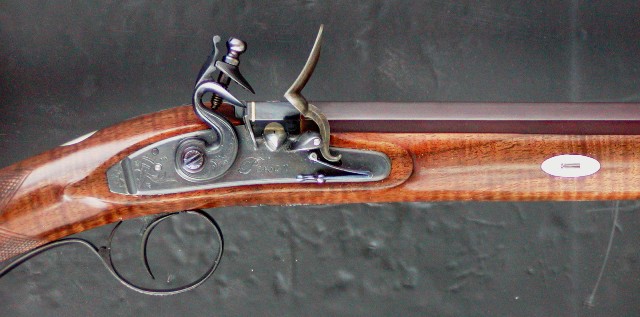
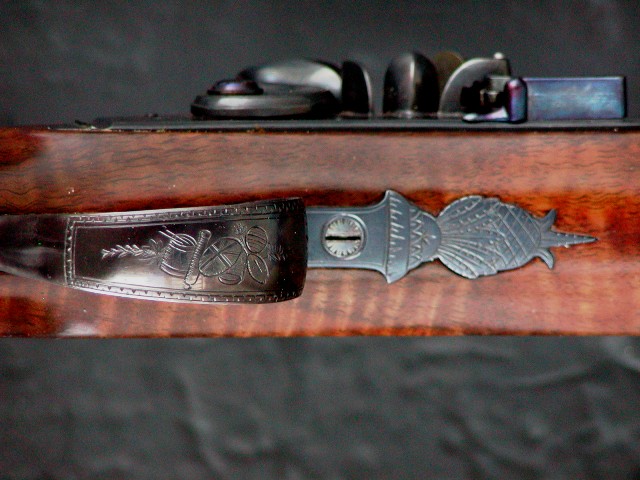
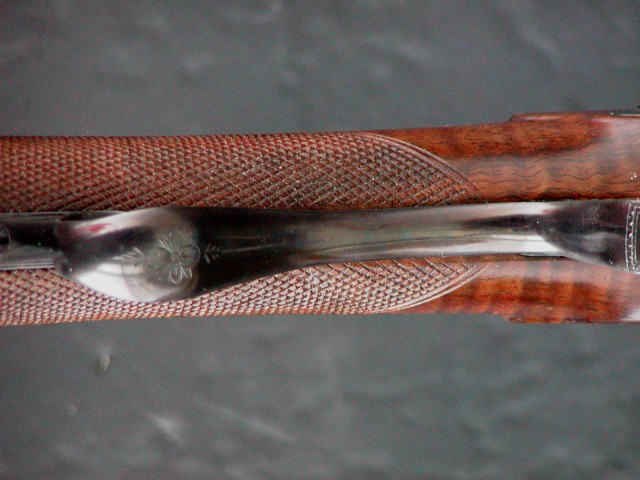
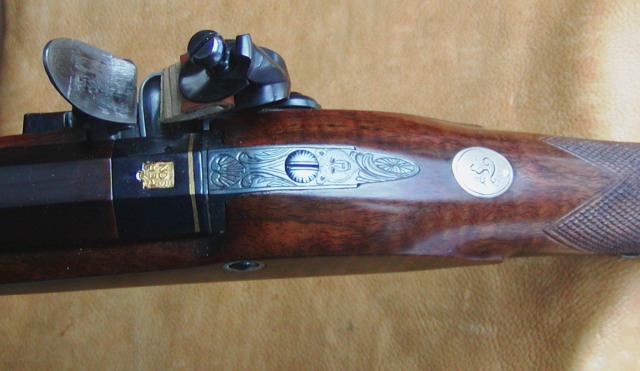
However, when it comes to the barrel, I found a reasonable alternative using rust bluing that looked much like earlier temper and charcoal bluing colors colors. I simply rust blued the barrel (of course it gets immersed in boiling water during that process) and then finally rubbed back the deep blue with Scotch Bright pads to give the color a more translucent appearance like good charcoal and fire bluing.
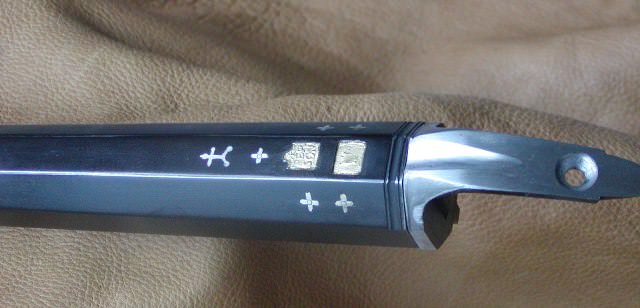
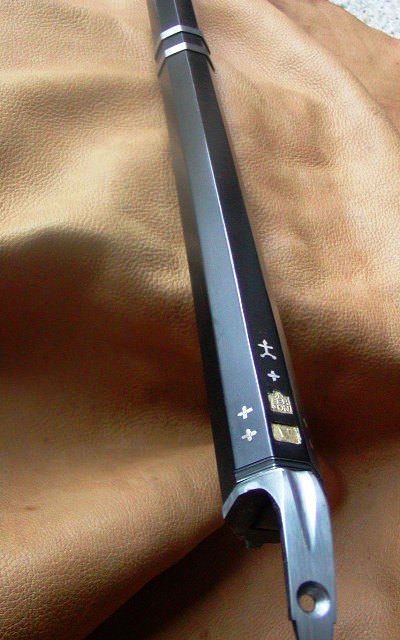
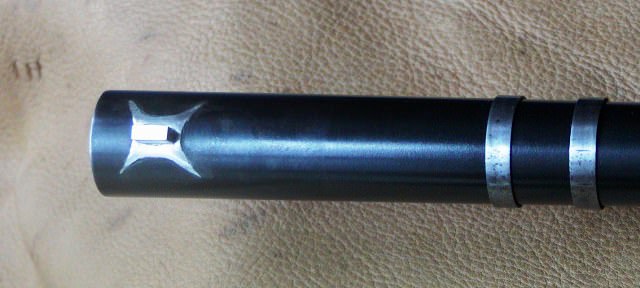
The secret, as always, is a nicely polished and degreased barrel. The better the surface of the steel, the brighter the colors.
The temper bluing on the locks below was done simply by placing the parts in my heat treating furnace (no charcoal pack) and programming it to heat them to 590-600 degrees for an hour. Again, the appearance is enhanced if the steel is well polished and degreased.
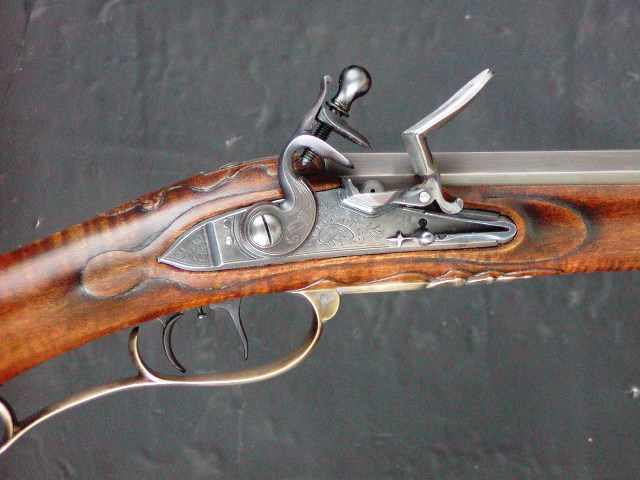
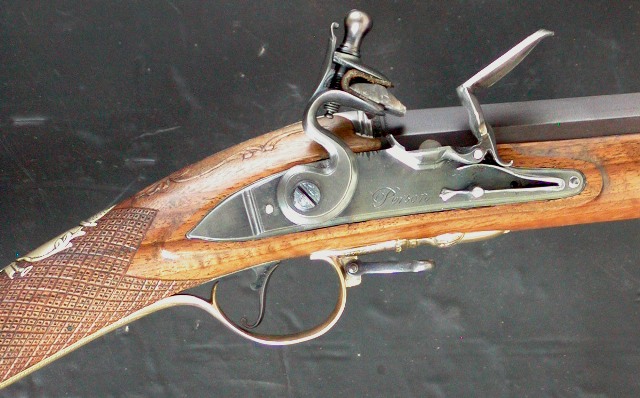
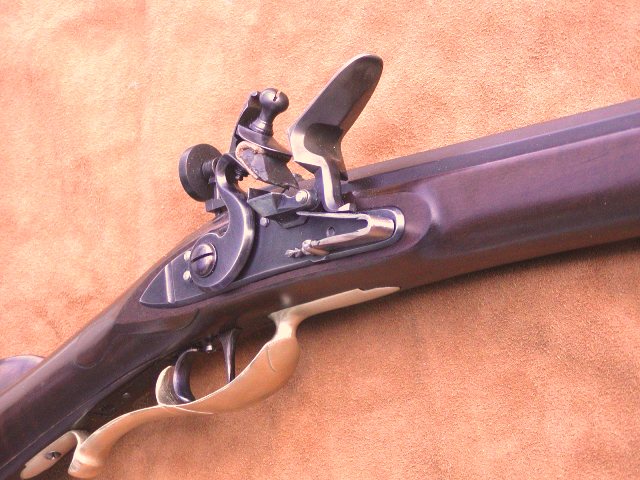
Simple temper bluing looks nice but it does not wear well over time and will eventually fade. Charcoal bluing is much more robust but not nearly as resistant to wear and rust as rust bluing.
dave
dave
No, the lid can be loose but the part needs to be packed tightly in the charcoal to prevent air from contacting the metal. I put a layer of wood charcoal first in the box, then pour in bone charcoal. The parts are bedded in the bone charcoal because of the finer grain and greater air exclusion capacity. I add more bone charcoal on top and fill out any residual space with wood charcoal. The top of my box is loose. I buy bone and wood charcoal from Brownells but I believe there are much cheaper sources. I don't recommend making it because it must be very clean burning to get good results. I am familiar with the guns you posted and suspect the barrels were temper (fire) blued. Essentially, they were polished bright, degreased and then placed among nonsmoking and mostly burnt coals in the forge. They were kept in the heat until the blue color emerged, immediately removed and rubbed with oil and emery, then degreasing, and heating again. It was almost like charcoal bluing except the barrel was not completely packed in the coals so the gunsmith could see the color change. A description of this can be found in the book "Espingarda Perfeyta", which is available online. It is a gunsmith manual written by 3 Portuguese brothers at the end of the 17th century and published in 1713. It was translated and republished in the 1980s.
These photos show charcoal bluing on a late flint English rifle I built.




However, when it comes to the barrel, I found a reasonable alternative using rust bluing that looked much like earlier temper and charcoal bluing colors colors. I simply rust blued the barrel (of course it gets immersed in boiling water during that process) and then finally rubbed back the deep blue with Scotch Bright pads to give the color a more translucent appearance like good charcoal and fire bluing.



The secret, as always, is a nicely polished and degreased barrel. The better the surface of the steel, the brighter the colors.
The temper bluing on the locks below was done simply by placing the parts in my heat treating furnace (no charcoal pack) and programming it to heat them to 590-600 degrees for an hour. Again, the appearance is enhanced if the steel is well polished and degreased.



Simple temper bluing looks nice but it does not wear well over time and will eventually fade. Charcoal bluing is much more robust but not nearly as resistant to wear and rust as rust bluing.
dave
dave
Phil Coffins
69 Cal.
Dave gives very good details on bluing. I have done it with good success using just wood charcoal. This test piece of mild steel was done at 800 degrees F in a loose fitted metal box and lump charcoal broken into pea sized grains.
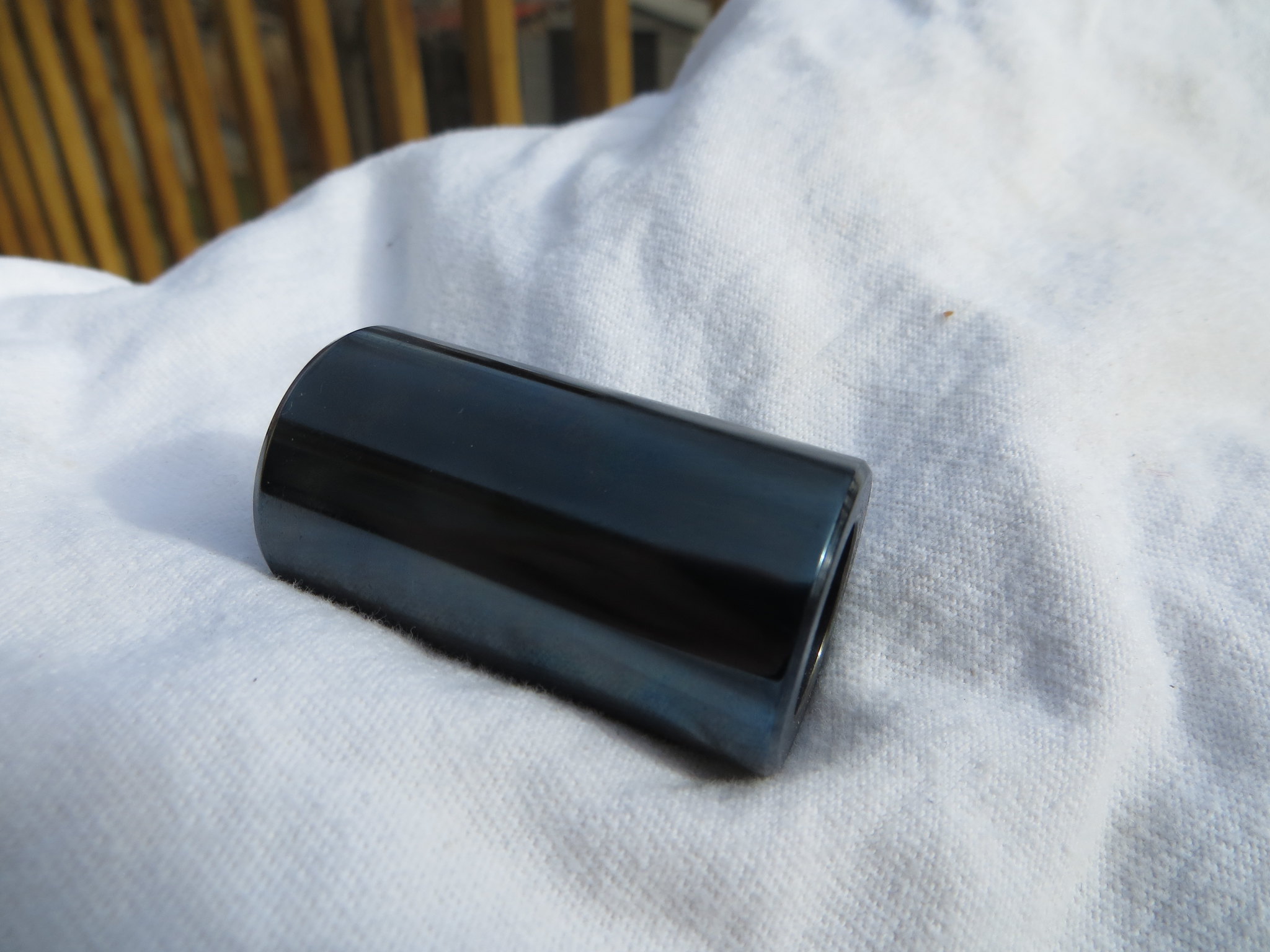 IMG_0241 by Oliver Sudden, on Flickr
IMG_0241 by Oliver Sudden, on Flickr
 IMG_0241 by Oliver Sudden, on Flickr
IMG_0241 by Oliver Sudden, on FlickrHi Dave. Thank you. That's the info I was looking for. I'll see if I can find the book you listed. May I ask how you learned your trade - are you self taught, served an apprentiseship, or a trade school? I am not looking to compete with guys like you that make a living doing this. I've spent my life fixing things others could not, do my own gun repairs, and now have found a late 16th century French wheellock I want to build a copy of. Not a museum grade copy, I plan to use it. I've drawn up an alternate interchangeable early flint lock with buffer to sub for the wheellock, if necessary. That's why I have so many questions. I have copies of all the commonly available resources for building muzzleloaders and have started making my own lock replacement parts. I look at your work and know I will never achieve the artistic level you have achieved. My goal is to achieve a 'workman like' level of expertise. Thanks, Bill
Similar threads
- Replies
- 8
- Views
- 676
- Replies
- 9
- Views
- 448
- Replies
- 8
- Views
- 349



